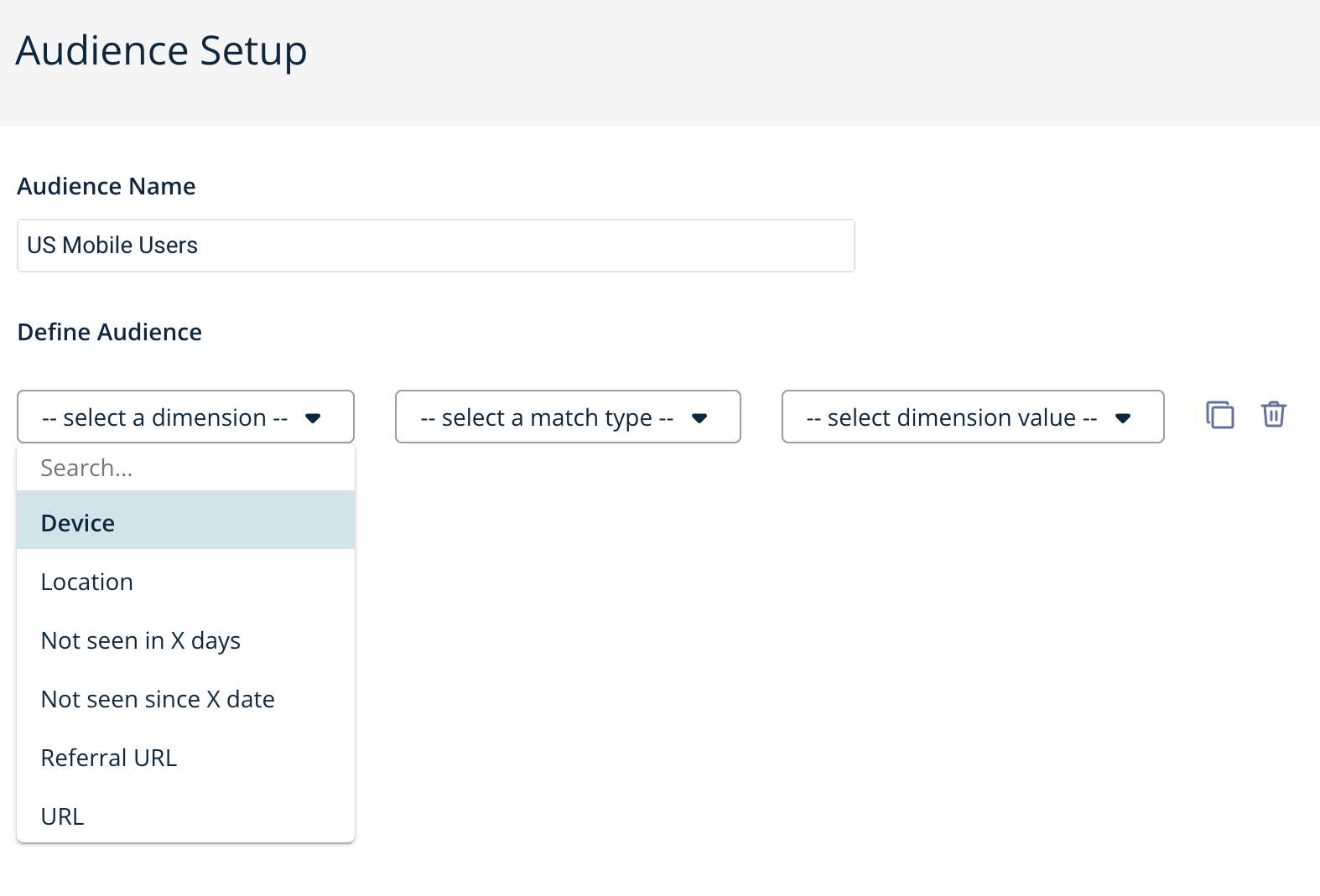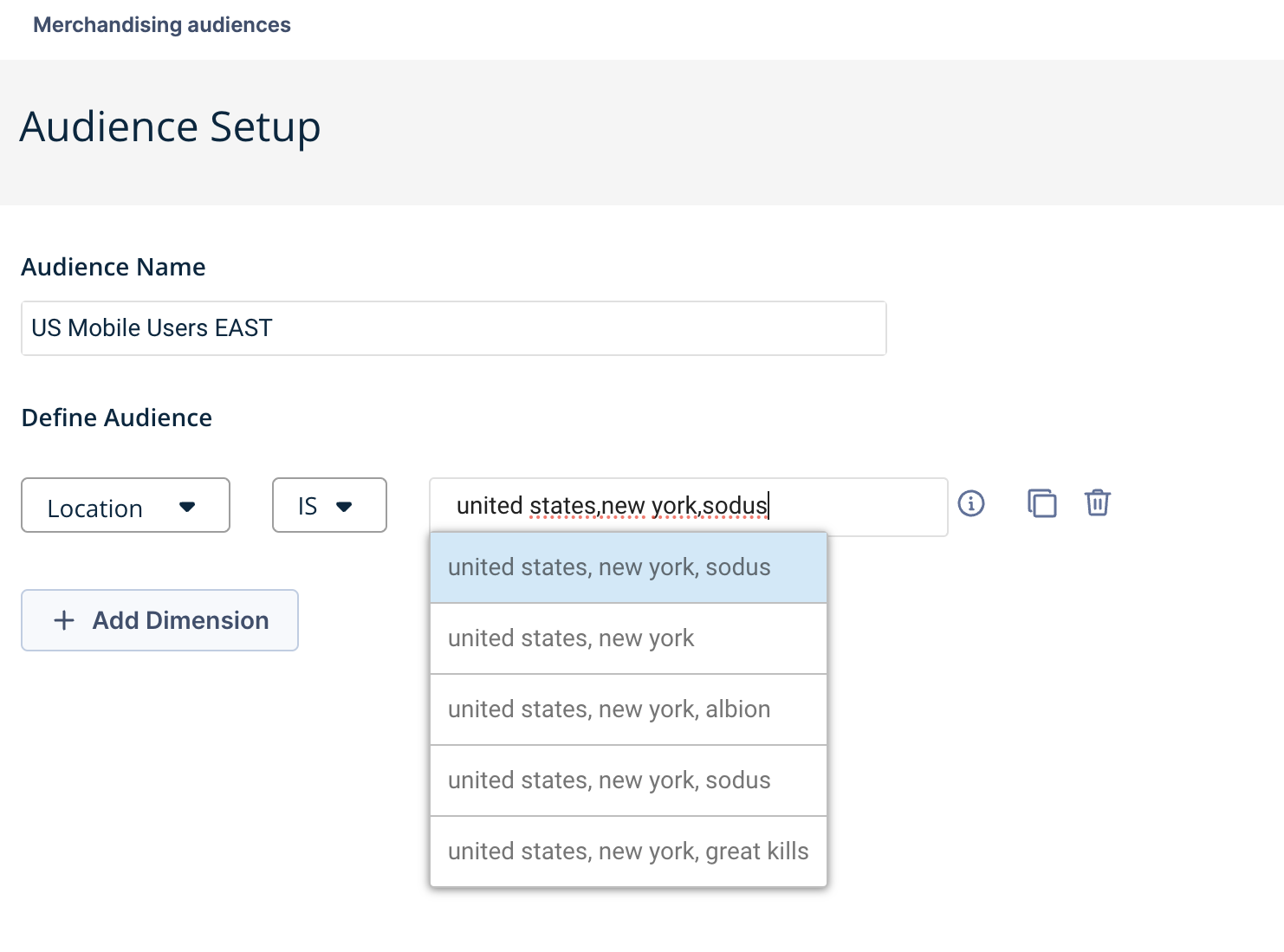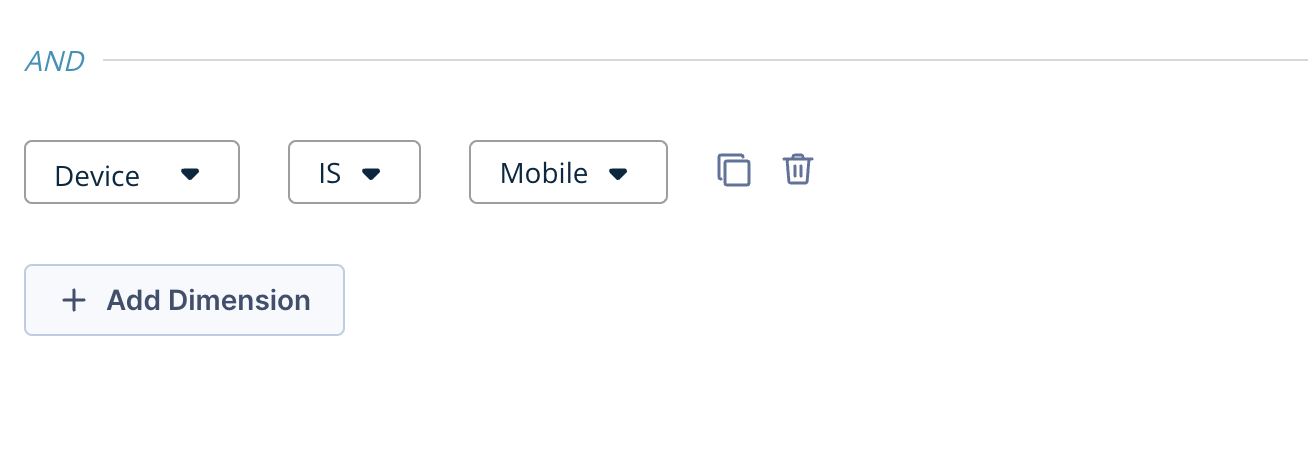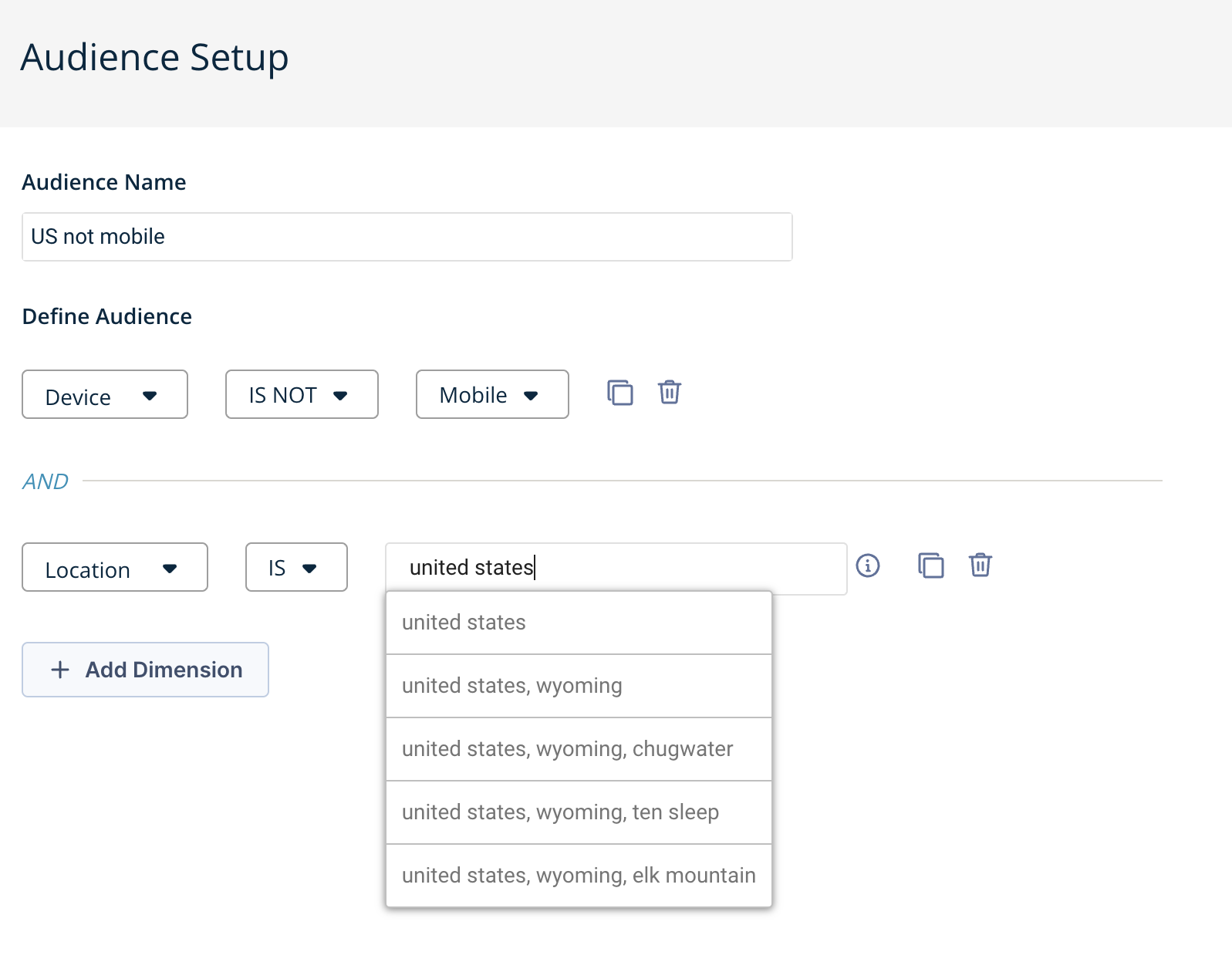Defining audiences for targeted changes
Why do I need to have defined audiences?
Merchandising audiences are groups of site visitors with specific characteristics. You can target changes to your site so that they affect only a specific set of visitors. For example, you can create a ranking rule that boosts certain products for visitors who arrive at your site from a specific URL.
Before you can target your changes, you need to define the targeted audience.
You use rules to make changes
Changes that you make to your site through the Bloomreach Dashboard are done through rules. For example, if you want to redirect keyword searches that use a certain search term, then you create a rule.
As you work with targeted changes, you're managing rules to make your changes just like any other change. When you create or edit a rule, you have the opportunity to stipulate the changes caused by your rule to affect only a certain audience.
Dimensions
An audience is defined by a set of dimensions. You can think of dimensions as attributes that describe specific characteristics of audience members.
Dimensions can be defined on your Bloomreach Dashboard while you set the audience for targeting. When you define an audience, you select at least one dimension. The default dimensions available are explained in the section below.
Default dimensions
These dimensions are provided by default in your Audience creation screen in the Bloomreach Dashboard. To skip to the steps, go to How do I add a new dimension section.
-
Device
-
Location
-
Not seen in X days
-
Not seen since X date
-
Referring URL
-
URL
Device
Use the device dimension if you want targeted rules to affect only people visiting your site from a specific device. For example, if you sell certain products only through mobile devices, then you might want to bury those products for audiences who use tablets and desktops.
Default values:
- Mobile
- Desktop
- Tablet
Location
The geographical location dimension includes a list of locations that you can select from. You can use this dimension to specify the location of audience members. For example, you might want to create a targeted rule that boosts artisanal cheeses for visitors located in France.
When you use this dimension, you need to start entering a location in the search field to trigger a list of suggestions. When you see the location you want, just click it and move on.
There isn't a default value for location. The location Dimension looks for the geographic location of the user's IP address.This can be as specific as a city as well as at a broader level capturing users coming from a state, province or a country.
You can define an audience with the same dimension used multiple times.
For example, Kusum is a digital marketer at Spiffy Tot. She wants to define an audience that uses only smartphones and tablets.
She selects the dimension Device and selects the match type “IS” and assigns the value “mobile”. Then she selects “OR” and selects the match type “IS” and assigns the value “tablet”. Defining the target audience in this way, Kusum can apply merchandising rules to visitors that land on Spiffy Tot via mobile devices or tablets only.
Not seen in X days
Not seen in X days dimension looks for users that haven't been seen on the site for a certain number of days that you define.
Not seen since X date
This dimension looks for users that haven't returned to the site since a given date that you define.
Referring URL
The referring URL dimension looks for the URL or the page from where your visitor came to your site.
URL
The URL dimension looks for parameters within the URL that your customer is on.
Best practices
Plan your audience
Before you define an audience, consider the kinds of changes that you anticipate for the audience. You can only assign one audience to a change, so the definition needs to include all the dimensions that describe the site visitors that you want to target.
For example, Kusum at Spiffy Tot wants to target a ranking rule at customers who live in Canada and visited the site at least once during the past month. She sees an audience already defined for customers living in Canada, and another audience defined for recent visitors. But she wants her new ranking rule to target both characteristics, so she defines her own audience.
Check the list of audiences that are already defined
A particular audience only has to be defined once. If you or someone else already defined the audience in the past, then you can skip straight to selecting that audience to target your promotion, rule, or other change.
Define your audience according to your organization's user personas
If you have a lot of custom dimensions, then it can require a lot of repetitive clicking to define an audience for every targeted change. We don't recommend that you put yourself to all that trouble.
Instead, consider defining audiences according to visitor or user personas that you might already have. And if you don't have these personas, then this might be a great opportunity to gather your stakeholders together and create them.
By defining audiences according to your own visitor personas, you not only save yourself from repetitive work, you also ensure that your rules in the Bloomreach Dashboard are aligned with your organization's larger marketing and merchandising efforts.
Note: If you're new to defining targeted audiences, then we recommend that you select just a few dimensions to see how it works. Complicated audience definitions increase the risk of rule conflicts. In case of hard conflict, Bloomreach uses the most recent rule as the dominant rule.
How do I define a new audience?
To define a new audience, follow the steps given below. In this example, we have created a target audience by defining the dimensions Location and Device.
- Go to Bloomreach Dashboard and click Merchandising audiences.
- Click + New Audience. The Audience Setup screen appears.
- Enter the Audience Name and select the dimensions from the drop-down list.

- To set a location-based audience, select Location.
- Select a match type as IS to include the specified location or IS NOT to exclude the specified location.Note: You can add multiple locations by selecting OR.

Suggested Method to Search for Locations
Remember to search using the enforced template below.
- Full Address: Enter the name of the country, followed by the name of the state and then the city. These must be separated by commas. Example:
united states,new york,sodus- City Only: Leave country and state blank if searching for a city name alone. Use double commas (,,) to indicate country and state are empty. Example:
,,sodus. If the city name isn't found, specify further by adding state and country.
- To set device-based targeting, select Device.
- Select a match type as IS to include the specified device or IS NOT to exclude the specified device.
- Select the type of Device from the drop-down as Mobile, Desktop or Tablet.

- Click Save to create and save the audience.
Dimensions are like attributes
You can think of dimensions as collections of attributes that describe specific characteristics of audience members. Click the select a dimension dropdown to see a list of the dimensions that you can configure for an audience. You might see the other dropdown lists change or text fields appear, depending on which dimension you select. Just use the lists and fields to set values for each dimension that you want to be part of this audience.
Setting up Multiple Dimensions
You can define multiple dimensions for an audience (Device, Location, URL, Ref URL) by selecting ADD DIMENSION button and defining each of the dimensions as per your requirement.

How do I edit an existing audience definition?
Start with the list of all the audiences defined for your site. You get there by clicking the Merchandising audiences option from the left menu.

Click the name of the audience to open it. Now, you can add, delete, and change dimensions until you're happy with the new definition. Click the Save button in the upper left corner when you're finished.

What happens if I delete an audience?
Deleting an audience automatically disables any rules that target that audience.
If there are no rules that target an audience that you want to delete, then you can simply delete the audience without affecting your site.
You can see if there are rules that target an audience by checking the Rules Affected column in the Audience Overview page, which has a list of all the audiences defined for your site. If there are rules that target the audience, then a confirmation box opens when you click the name of the audience.
What is the scope of applying audiences?
You can apply target audiences to different entities within the dashboard. These include:
- Search ranking rules
- Search facets
- Category ranking rules
- Category facets
- Redirects
- Global search and category rules
- Global facet rules
- Campaigns from respective sections.
How is the conflict resolved when a user belongs to more than one audience segment?
When different rules for a single query is applied, and the user belongs to more than one audience segment, a conflict scenario can arise.
In such cases, first, the rules for different audience segments are merged. Although when there is a direct/hard conflict for any product, the latest modified rule (the one that was most recently modified/created) will be applied for conflict resolution.
For example, assume 2 geography-based rules overlap. One rule targets all of Eastern Canada (5 provinces, including Ontario), and another targets only Ontario. Let's say for Eastern Canada, the query "bike" has been boosted for products A and B, and for Ontario, products C and D are boosted for the same query.
The expected experience for a user from Ontario, Canada, with the query "bike" would be that all the products A, B, C, and D will be boosted.
Note
You could also use "IS NOT" match type in Merchandising audiences application if you would like to exclude users from specific cities from the province level segments to avoid such conflicts.
Updated 7 months ago
